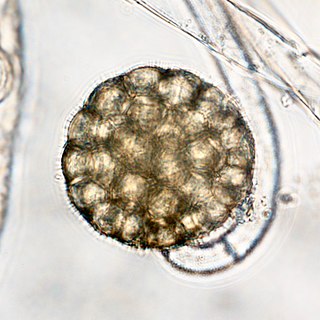
The Russulaceae are a diverse family of fungi in the order Russulales, with roughly 1,900 known species and a worldwide distribution. They comprise the brittlegills and the milk-caps, well-known mushroom-forming fungi that include some edible species. These gilled mushrooms are characterised by the brittle flesh of their fruitbodies.

Lactarius is a genus of mushroom-producing, ectomycorrhizal fungi, containing several edible species. The species of the genus, commonly known as milk-caps, are characterized by the milky fluid ("latex") they exude when cut or damaged. Like the closely related genus Russula, their flesh has a distinctive brittle consistency. It is a large genus with over 500 known species, mainly distributed in the Northern hemisphere. Recently, the genus Lactifluus has been separated from Lactarius based on molecular phylogenetic evidence.

Lactifluus deceptivus, commonly known as the deceiving milkcap, is a common species of fungus in the family Russulaceae.

Lactifluus clarkeae, formerly known as Lactarius clarkeae, is a species of mushroom-forming fungus in the family Russulaceae. It is found in Australia and New Zealand in mycorrhizal association with species of Nothofagus and the family Myrtaceae.

Backusella is the sole genus of zygote fungi in the family Backusellaceae, which is classified in the order Mucorales. Members of this genus have been often isolated from plant litter, from locations around the world.
Backusella liffmaniae is a species of zygote fungus in the order Mucorales. It was described by Andrew S. Urquhart and James K. Douch in 2020. The specific epithet is in honour of Patricia Liffman, who contributed to the protection of ex-type locality. The type locality is Jack Cann Reserve, Australia.
Backusella mclennaniae is a species of zygote fungus in the order Mucorales. It was described by Andrew S. Urquhart and James K. Douch in 2020. The specific epithet is in honour of Australian mycologist Ethel Irene McLennan. The type locality is Morwell National Park, Australia.
Backusella morwellensis is a species of zygote fungus in the order Mucorales. It was described by Andrew S. Urquhart and James K. Douch in 2020. The specific epithet refers to the type locality; Morwell National Park, Australia.
Backusella parvicylindrica is a species of zygote fungus in the order Mucorales. It was described by Andrew S. Urquhart and James K. Douch in 2020. The specific epithet is from Latin parvus (small) and Greek kylindros (cylinder), referring to the sporangiospore dimensions. The type locality is Jack Cann Reserve, Australia.
Backusella psychrophila is a species of zygote fungus in the order Mucorales. It was described by Andrew S. Urquhart and James K. Douch in 2020. The specific epithet refers to the inability of this species to grow above 30 ˚C. The type locality is Jack Cann Reserve, Australia.
Backusella tarrabulga is a species of zygote fungus in the order Mucorales. It was described by Andrew S. Urquhart and James K. Douch in 2020. The specific epithet refers to the type locality; Tarra-Bulga National Park, Australia.
Backusella westeae is a species of zygote fungus in the order Mucorales. It was described by Andrew S. Urquhart and James K. Douch in 2020. The specific epithet is in honour of mycologist Gretna Margaret Weste. The type locality is Tarra-Bulga National Park, Australia, from which the type specimen was inadvertently isolated from a Laccaria basidiome.
Dr Teresa Lebel is a taxonomist and ecologist who works on fungi, with a particular interest in subterranean truffle-like fungi and their mushroom, bolete, bracket or cup relatives.
Lactifluus jetiae is a species of mushroom-forming fungus in the family Russulaceae. It was described by Luke Vaughan, Lachlan Tegart, James K. Douch, and Teresa Lebel in 2021. The specific epithet is a Latinisation of the initials JET, in honour of Jennifer E. Tonkin, who had collected and preliminarily analysed many Australian members of the Russulaceae. The type locality is near the Cann River, Australia.
Lactifluus rugulostipitatus is a species of mushroom in the family Russulaceae. It was described by James K. Douch, Lachlan Tegart, Luke Vaughan, and Teresa Lebel in 2021. The specific epithet refers to the longitudinally wrinkled stipe that is characteristic of this species. The type locality is near Mount Bundey, Australia.
Lactifluus albens is a species of mushroom in the family Russulaceae. It was described by Teresa Lebel, James K. Douch, and Luke Vaughan in 2021. The specific epithet is Latin (bleached), named for the pale cream to buff colouration of basidiomata. The type locality is Dwellingup, Australia.

Lactifluus aurantioruber is a species of mushroom in the family Russulaceae. It originally described by McNabb as Lactifluus clarkeae var. aurantioruber in 1971, named for its reddish-orange colour. Jerry A. Cooper raised this variety to species-rank in 2021, thus acquiring the name Lactifluus aurantioruber. The type locality is Tongariro National Park, New Zealand.
Lactifluus psammophilus is a species of mushroom in the family Russulaceae. It was described by Teresa Lebel, James K. Douch, and Luke Vaughan in 2021. The specific epithet is Latin (sand-loving), referring to this species' habitat. The type locality is Bunyip State Park, Australia.
Lactifluus pseudoflocktoniae is a species of mushroom in the family Russulaceae. It was described by Teresa Lebel, James K. Douch, Lachlan Tegart, and Luke Vaughan in 2021. The specific epithet refers to Lactifluus flocktoniae, to which this species has a strong resemblance. The type locality is near Cann River, Australia.





